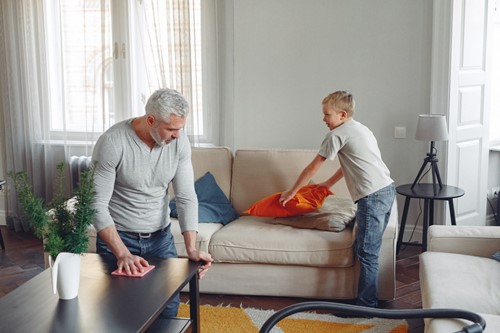
Staging your home to sell is a process that can involve many details. You want to make sure your home looks the best it might be so that it sells quickly and for a high price. Professional home stagers are there to help you with strategy and expert advice, but there are plenty of things you can do on your own. If you choose to take on staging your house yourself, there are some important do’s and don’ts.
Do: De-Clutter
The first step in any home staging project is to clean up your home. This means things like sweeping and dusting, but it also means removing, organizing or putting away any items that could look messy or unkempt. The most common sources of home clutter are books, children’s toys and dishes, so make sure you look out for them. Books that won’t fit on shelves can be stored or donated, and toys should be tucked away accordingly. In the kitchen, make sure your countertops are completely clear of foodstuffs, dishes and utensils. If you have lots of accessories or small decorations on surfaces like tables or shelves, consider paring down the number to create the illusion of more space.
Don’t: Forget the Yard
Your outdoor spaces might need some help with clutter as well. Don’t neglect your gardening tools or sports equipment that might be lying around. You will want to store or remove anything that could distract from the great selling points of your outdoor spaces. Removing weeds and trimming lawn edges also go a long way toward making your yard look tidy, as well as raking leaves or cleaning debris from walkways and patios.
Do: Neutralize Decor
If you have brightly colored walls or decor it’s time to tone things down. This can include everything from walls to window treatments, furniture and bathroom tile. Soft, neutral colors like gray, white and taupe create a blank canvas for potential buyers to imagine their own lives and personalization in a room. Keeping your color palette light will also make better use of the home’s natural light and make spaces feel larger. Invest in some paint and swap out your boldly colored furnishings for neutrals, and you’ll make sure buyers can see the home’s assets in the best possible light.
Don’t: Cause Confusion
Simplifying and neutralizing color and decor is essential to home staging, but don’t take it too far. You don’t want to remove so much furniture and life from a room that its function becomes unclear. Allowing buyers to imagine their own use of space is good, but you don’t want every single room to run together in their memory. Try defining multi-purpose rooms by a single theme to keep it simple and memorable. For example, keep the home office and home gym separate spaces. Empty and unfinished spaces like basements or attics should have enough furnishing to show their potential to buyers without locking them in to a concept or causing confusion.
There are just a few of the important things to think about when staging your home. No matter what changes you make or don’t make, as long as you remember to highlight the home itself rather than the decoration, you’ll be on the right track to a quick and easy sale.
About the Author

Holli Miner
Hi! So glad you're here! If you're looking for an enthusiastic realtor or an equally energetic home stager, you have found both; one stop shopping, who doesn't love that?! Learn more about me in my "About" biography, and feel free to call, text, or email anytime with any questions. If you're looking to buy OR sell, I would be thrilled to be considered for the job of being the realtor who will get you where you want to be!
